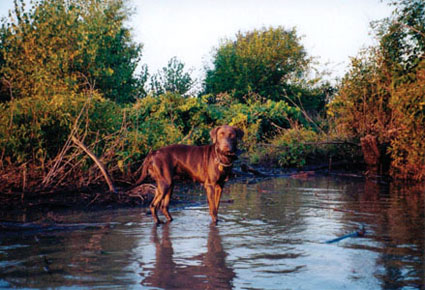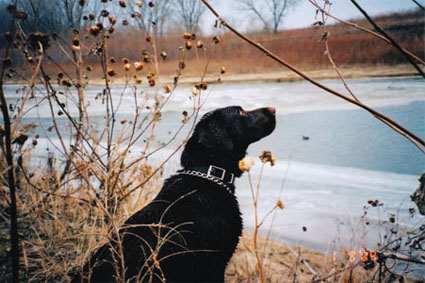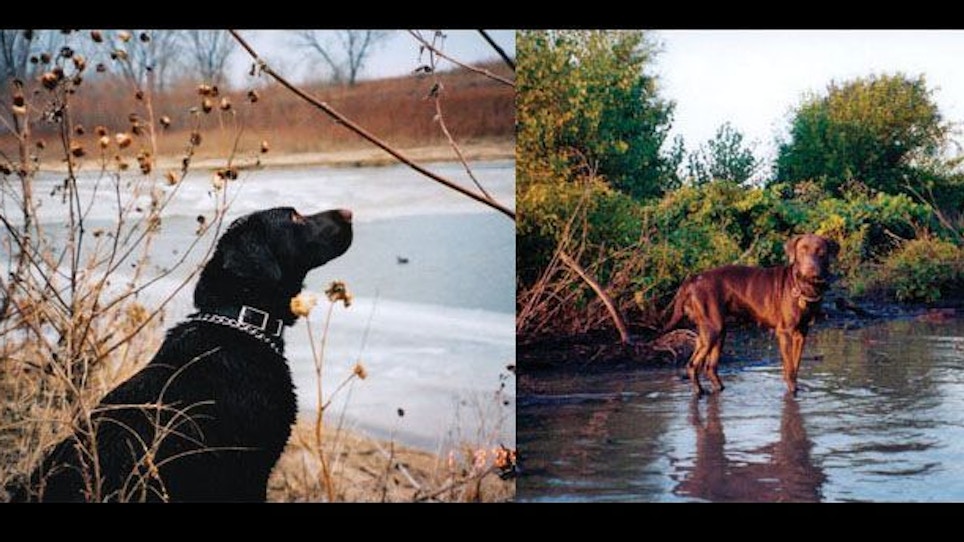 Hypothermia. None of you reading this are unfamiliar with the word, but you usually hear about it in conjunction with lost hikers and mountain climbers and duck hunters who get in over their waders — not working dogs. Yet hypothermia in canines occurs.
Hypothermia. None of you reading this are unfamiliar with the word, but you usually hear about it in conjunction with lost hikers and mountain climbers and duck hunters who get in over their waders — not working dogs. Yet hypothermia in canines occurs.
Hypothermia is a lowering of the core body temperature to dangerous levels. For dogs, that means anything below their normal range of 100.5 to 102.5 degrees Fahrenheit. Signs of hypothermia in your working dog can be subtle at first and easily missed. Is he shaking in anticipation of a retrieve, or is he really cold? Is he breathing hard because he fought a tough current on the way back, or is he actually having trouble catching his breath? Did he miss the ladder because it’s coated in ice, or does he suddenly not have the strength to get himself back in the boat? When such things happen, you need to watch carefully, because if any of these incidences are symptoms of hypothermia, you need to take immediate action. Delayed treatment of hypothermia, in dogs or in humans, can lead to death.
Some observations are easy to make. When I’m hunting with my Lab, for instance, he generally doesn’t shake. He does gaze into the distance, scanning the sky for birds, especially when gun muzzles get raised. This is part of knowing my dog and his peculiarities, just like you’d expect to know your spouse in such a personal way. So when I see my dog tremble and I note that conditions are past the chilly side of things, I watch him closely. And when it looks like the shivering is more than occasional, he’s out of there. No more retrieves in cold water, and he’s going to be made to lie down in the bottom of the boat, out of the wind and with a spare parka or some such thing under and/or over him. What I don’t want to see are eyes that were anxiously scanning the skyline suddenly becoming dilated orbs that stare at nothing. If he gets that far, he’s in trouble.
Thawing Out
Trouble happens, even when we’re watching closely, and it might happen when you least expect it. The limits are shot, the blind is lowered, and you head back to shore with your dog riding in the stern. You get the boat on the trailer, just about ready to pull out, and suddenly your four-legged companion can’t make the jump to the tailgate. Hypothermia has set in thanks to the wind chill on the long boat ride. So what do you do? In this case, skip the kennel in the pickup truck bed. This dog needs to be in the heated cab, preferably on your lap and with your parka wrapped around him. In fact, I’d keep a supply of “doggie” blankets on hand for just this kind of situation.
I’d also pump some energy into him. Hypothermia can more easily set in when blood sugar is low, so if you’ve sent your dog on a dozen retrieves in icy water and he hasn’t had anything in him since dinner last night, he might need a boost. If you can get him interested enough in a treat, then something like the Xtreme Fuel Booster Bars from Realtree can start him on the path to recovery. I’d also keep this product on hand in its liquid form. Called Xtreme Fuel Quencher, this is a powder that, when mixed with warm water, delivers a load of protein, carbohydrates and electrolytes. In fact, if you Google “dog electrolyte supplements,” you can come up with a variety of products that can help get your dog recovered during a hypothermic event. (Word to the wise, keep a thermos of warm — not hot — water on hand and an oversized hypodermic syringe that your vet can supply. A dog becoming hypothermic can and will be decidedly disinterested in food or drink as the condition progresses. With the syringe, you can get warm liquid into him if he won’t take it himself.)
Simple external warming and a replenished energy supply will have most dogs back up and ready to go in short order. But what do you do if your retriever has gotten past the early stages?
 Get him to a vet. Now. Do not go home; do not stop for breakfast. Keep him wrapped on the way and the heater going full blast, and keep in mind that time is of the essence. As hypothermia progresses, the symptoms worsen. Your dog will become stiff, his pupils will dilate, he might have significant trouble breathing, his heart rate will slow, and he might slip into a coma. No one but a qualified veterinarian can fix this, usually through a combination of heating pads, IV fluid therapy and warm-water enemas and stomach washings to warm the dog from the inside out. The animal might also need supplemental oxygen, as well as repeated monitoring through electrocardiograms and possibly blood and urine chemistries. Get out your checkbook — if you’ve let your dog get this far, it’s going to cost you.
Get him to a vet. Now. Do not go home; do not stop for breakfast. Keep him wrapped on the way and the heater going full blast, and keep in mind that time is of the essence. As hypothermia progresses, the symptoms worsen. Your dog will become stiff, his pupils will dilate, he might have significant trouble breathing, his heart rate will slow, and he might slip into a coma. No one but a qualified veterinarian can fix this, usually through a combination of heating pads, IV fluid therapy and warm-water enemas and stomach washings to warm the dog from the inside out. The animal might also need supplemental oxygen, as well as repeated monitoring through electrocardiograms and possibly blood and urine chemistries. Get out your checkbook — if you’ve let your dog get this far, it’s going to cost you.
An Apple A Day …
… Keeps the doctor away, right? That’s the old cliché for prevention, but it’s worth emphasizing here, because the best way to deal with hypothermia is to stop it from happening in the first place. A dog vest, a kennel jacket (check out the Insulated Classic Kennel Jacket from Mack’s Prairie Wings) and boots such as the Bark’n Boots Grip Trex from Ruffwear (www.ruffwear.com) are great gear investments that will help keep your dog healthy in cold weather.
A Few Extras
Common sense should be applied. For example, maintaining a healthy weight is critical to keep your dog going all day in adverse conditions, but many cold-weather waterfowlers feel the need to put fat on their dogs. Don’t. The extra weight is hard on the heart, lungs and joints, and it bogs down a dog’s energy levels. A neoprene vest is a much better insulator than excess body fat.
You can maintain a healthy weight and provide a more consistent energy level by feeding your working retriever high-quality dog food that has a protein content of 30 percent and has chicken as its main ingredient. And don’t free-feed your dog. Many dogs that are allowed to pick at a bowl of food whenever they want won’t eat when they need to, such when they get excited seeing the hunting gear come out of storage. Feed your dog at the same time(s) every day and pick up the bowl after 10 minutes if he’s just noodling the food. He’ll get hungry this way and will soon learn to concentrate on finishing the food in one sitting — this is the key to keeping energy levels as high as possible throughout a hunting day.
Clip the hairs between your dog’s pads to a short length. It’s these long hairs that gather snow and compact it into painful ice balls that your dog will gnaw at.
Have a supply of dog towels on hand in the boat and use them to towel your dog off so water doesn’t freeze to his coat. Pay special attention to drying off sensitive noses and ears, as well as paws.
If you’re willing, keep your dog housed outside (obviously with adequate shelter). This allows him to stay better acclimated to cold temperatures. If you house your dog in your home, be prepared to use the dog vests and keep your hunting times afield shorter.
Make sure your dog is hydrated. If he’s working hard, he’ll drink, cold weather or not. Again, keeping a thermos of warm water on hand can help keep him heated from the inside, especially when paired with an electrolyte supplement.
If he’s cold and wet, don’t let him ride in the stern on the boat ride home. Make him lie down in between seat benches so that he’s out of the wind, and even if you didn’t use a vest while hunting, putting one on him for the ride home can help keep him warm once the activity stops.
Carry a first-aid kit that includes both a thermometer and a space blanket. If you think your dog is beginning to show signs of hypothermia, the thermometer will help confirm it and the space blanket will help to start the reversal process.
Super-cold surfaces are hard on a dog’s paws and can cause sore, cracked pads. Keep a mat or even just a pile of burlap bags or the empty decoy sacks between the dog and the boat deck.






